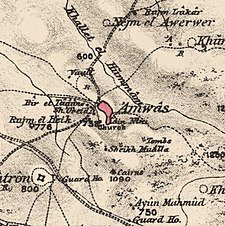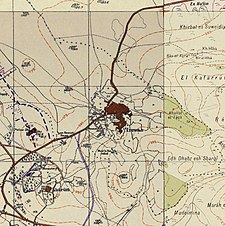Imwas
عِمواس 'Amwas, Amwas | |
|---|---|
Village | |
 Imwas, early 20th century | |
| Etymology: possibly "thermal springs"[1] | |
A series of historical maps of the area around Imwas (click the buttons) | |
Location within Mandatory Palestine | |
| Coordinates: 31°50′26″N 34°59′30″E / 31.84056°N 34.99167°E | |
| Palestine grid | 149/138 |
| Geopolitical entity | Mandatory Palestine |
| Subdistrict | Ramle |
| Date of depopulation | 7 June 1967 |
| Population | |
| • Total | 2,015 |
| Cause(s) of depopulation | Expulsion by Israeli forces |
| Current Localities | Canada Park |
Imwas or Emmaus (Arabic: عِمواس ʿImwās), known in classical times as Nicopolis (Greek: Νικόπολις, lit. 'City of Victory'), was a Palestinian village located 12 kilometres (7.5 mi) southeast of the city of Ramla and 26 kilometres (16 mi) from Jerusalem in the Latrun salient of the West Bank.[2] It is traditionally (possibly from as early as the 3rd century, but probably incorrectly) identified with the biblical Emmaus.[3] Its population was expelled and its buildings razed by Israeli forces in 1967.
After the 1948 Arab-Israeli war, Imwas fell under Jordanian rule. Its population at the time was predominantly Muslim although there was a Palestinian Christian minority. Captured by the Israeli Defense Forces during the Six-Day War on June 7, 1967 along with the neighbouring villages of Yalo and Bayt Nuba, the villagers of Imwas were expelled and the village destroyed on the orders of Yitzhak Rabin.[4] Today the area of the former village lies within Canada Park, which was established by the Jewish National Fund in 1973.
- ^ Palmer, 1881, p. 283
- ^ Wareham and Gill, 1998, p. 108.
- ^ Siméon Vailhé (1909). "Emmaus". The Catholic Encyclopedia. Vol. 5. New York: Robert Appleton Company.
Today 'Am'was (the native name) is a Mussulman village about eighteen miles from Jerusalem, on the road to Jaffa. There are still visible ruins of a beautiful basilica built in the fourth or the fifth century, and repaired by the Crusaders. Near 'Am'was, at El-Atroun, the Trappists founded a priory in 1890. In the opinion of many 'Am'was is the Emmaus of the Gospel (Luke 24:13-35), where Christ manifested Himself to two of His Disciples. Such is, indeed, the tradition of the Church of Jerusalem, attested as early as the fourth century by Eusebius of Cæsarea, Titus of Bostra, and St. Jerome, a tradition confirmed by all pilgrims, at least to the time of the Crusades; it may even date back to the third century to Julius Africanus and Origen. It is also supported by many Biblical commentaries, some of which are as old as the fourth or the fifth century; in these the Emmaus of the Gospel is said to have stood at 160 stadia from Jerusalem, the modern 'Am'was being at 176 stadia. In spite of its antiquity, this tradition does not seem to be well founded. Most manuscripts and versions place Emmaus at only sixty stadia from Jerusalem, and they are more numerous and generally more ancient than those of the former group. It seems, therefore, very probable that the number 160 is a correction of Origen and his school to make the Gospel text agree with the Palestinian tradition of their time. Moreover, the distance of 160 stadia would imply about six hours' walk, which is inadmissible, for the Disciples had only gone out to the country and could return to Jerusalem before the gates were shut (Mark 16:12; Luke 24:33). Finally, the Emmaus of the Gospel is said to be a village, while 'Am'was was the flourishing capital of a 'toparchy'. Josephus (Ant. Jud., VII, vi, 6) mentions at sixty stadia from Jerusalem a village called Ammaus, where Vespasian and Titus stationed 800 veterans. This is evidently the Emmaus of the Gospel. But it must have been destroyed at the time of the revolt of Bar-Cocheba (A.D. 132-35) under Hadrian, and its site was unknown as early as the third century. Origen and his friends merely placed the Gospel Emmaus at Nicopolis, the only Emmaus known at their time. The identifications of Koubeibeh, Abou Gosh, Koulonieh, Beit Mizzeh, etc. with Emmaus, as proposed by some modern scholars, are inadmissible.
- ^ Oren, M.B. (2017). Six Days of War: June 1967 and the Making of the Modern Middle East. Random House Publishing Group. p. 306. ISBN 978-0-345-46431-6.
© MMXXIII Rich X Search. We shall prevail. All rights reserved. Rich X Search





